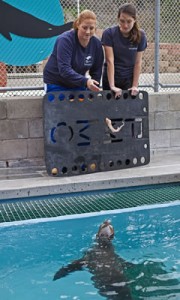By Ben Bodart, Special to the Independent

The three-month birthing season for seal pups nears its end this month. By now some have weaned and are foraging successfully on their own, but historically many fair poorly. As a consequence, spring begins peak season for Laguna Beach’s Pacific Marine Mammal Center, the only rescue center for marine mammals along Orange County’s 42 miles of coastline.
Even before the anticipated influx of sickly juveniles, the center is presently caring for eight California sea lions and an elephant seal.
Generally, the animals arrive at the center due to injuries from attacks by sharks and other marine mammals. The ocean is a dangerous place for pups; they often must fight for the territory, explained Kirsten Sedlick, 35, a staff supervisor at the center, who lives nearby in Aliso Viejo.
Humans also impact seal habitat. Locally, the ocean sometimes turns red due to the presence of domoic acid, which can poison sea animals. “Domoic acid is something natural in the ocean. But human beings and pollution increase the level of density and it becomes dangerous for the animals,” said Sedlick
The center treats between 200 and 250 animals a year. They have two trucks ready to pick up injured animals. On a busy day, they make five rescues, she said.
To feed all of the rescued animals during the busy season, the daily requirement can be more than 20 boxes of fish or 625 pounds of food per day. Back in 2010, for the six months high busy season, the cost of feeding was $50,000.
When an animal arrives at the center, its needs are assessed the way staff at a hospital emergency room attends to patients. “When an animal arrives we may take it into the lab to conduct an initial physical or typically put the animal into the appropriate pen to take vitals heart rate, respiration, lung sounds, take temperature, glucose, check the body for any wounds, tube feed a Pedialyte formula to start the rehydration process. The animal is not sedated. We wear protective gloves when handling the animals for safety,” said Michele Hunter, the center’s director of animal care.
The center’s veterinarian and medical director, Dr. Richard Evans, examines the animal patients and prescribes treatments. “He maintains all medical databases and writes research papers on various findings. He is a pathologist by trade so he conducts post-mortem examinations on all deceased patients and interprets the findings,” said Hunter.
About 80 percent of the rescues survive. “The most animals we have had in house was 100. During busy season the numbers are usually between 65 to 75,” said Hunter. The animals recuperate in five pools and three pens.
Even when the center isn’t overflowing with patients, there is no time out for the team. “Sometimes, we do not even have the time to sit down for a second. I would say that the mornings and the feeding are the most important part of the day, but all day long, we have to check on our animals to keep them warm or clean,” said Sedlick.
A year ago, staff and volunteers were diverted from their rescue work after destructive flooding by a December 2010 deluge. Water five feet high swept through the center. The ordeal’s aftermath contained a silver lining, a show of solidarity from the community. “While we were cleaning everything, people from Laguna came to offer us some snacks and their help. We are really thankful to all the community for their interest and support,” said Sedlick.
The staff of eight is supplemented by a small army of 75 volunteers, who arrive for morning and afternoon shifts. They help feeding the animals, cleaning pools and giving tours and explanations to visitors. “I did not know anything about seals when I arrived here,” said Billy Long, a two-year volunteer, “but I love the ocean and I just wanted to help. Now I come one time a week to help and I really enjoy it.”
The volunteers come from throughout Orange County and from all professions: chef, pilot, police officer, teacher, geologist. They all have the same passion for the ocean and they form a big family. “We have two volunteers, Frankie and Ashley, who met each other here. They are not married yet, but we love teasing them about that,” Sedlick said.
The center screens volunteer, who are selected based on their motivation and willingness to commit to a year of service. But people can help without volunteering.
Donations, grants and fundraisers are the center’s primary resources. “Even a $20 donation is welcome,” said Sedlick. “We sometimes have touching situations. One time, a young child did not want to receive anything for his birthday. He just wanted to give supplies for the seals. So he and his mother brought a trunk full a supplies.” These actions help the Center to maintain its annual budget of about $1 million and to focus this money on animal care.
To educate people and especially children, classes are organized at the center. “It is an easy way to raise awareness and to let the people know what we do here,” said Sedlick.
“The education program allows students like ours to see the work that is being done to be a protective voice for animals,” said Heidi Badertscher, a teacher from Anaheim’s Fairmont Private School, after a recent visit.
Classes also explain to people what to do when they find a stranded marine mammal on the beach. The first advice is clear: Stay back! Even if a seal is cute, it also is a wild animal that can bite. Call the PMMC or alert a lifeguard. “Practically all the lifeguards know the number of the center,” said Sedlick. “Now, with all the technologies we have, they also send pictures to show us what we are going to deal with.”




